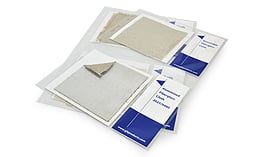Heating, ventilation, and air conditioning (HVAC) systems are a crucial part of any building. Whether it’s a small house, a medium-sized office building, or a large manufacturing facility, HVAC systems play an integral role in providing much needed airflow and temperature regulation throughout the structure. However, HVAC systems often generate unpleasant noise pollution, typically in two distinct ways.
One way noise is generated is by the flow of air. HVAC systems produce large gusts from fans or blowers in order to propel air throughout the system. In some situations a low amount of air movement can create a somewhat pleasant “white noise effect”. Most situations, however, require larger volumes of air movement rushing through a complex system of metal ductwork. This ductwork acts as a highway for echoes and noise. Noise reduction products are required to reduce noise to levels tolerable to building occupants.
Another way noise is generated from HVAC systems is through vibration. Over time, the hangers and supports can loosen, allowing the ductwork to sway and vibrate. In addition, ductwork made from sheet metal can warp or bend, which then flexes and vibrates with increased airflow. This vibration can start out as a mild rattling sound, and if left untreated, eventually works its way up to unpleasant decibel levels.
In order to successfully insulate a HVAC system from unwanted noise pollution, both issues must be addressed. If that weren’t enough, not only must the insulating product tackle these two issues, but it also must live up to standards such as ASTM E84 Standard Test Method for Surface Burning Characteristics of Building Materials. Most of the major building codes in the United States reference ASTM E84, which rates a product for its flame spread and smoke development.
How do you address both causes of HVAC noise pollution and stay within building fire codes? There are a number of products on the market that meet both of these requirements. One of the more popular choices is Mass Loaded Vinyl (MLV) with a foil facing.
Another solution would be a Mass Loaded Vinyl (MLV) product that has both the foil facing and a quilted fiberglass decoupler. Sound waves originating from the source will initially be absorbed by the fiberglass and then blocked by the mass loaded vinyl. Any reflected sound wave component will be further dissipated into the fiberglass absorber. It is recommended to always check with your local building codes before the installation of any MLV product for noise suppression.
Mass Loaded Vinyl can solve many challenging noise issues, and HVAC is just one of the many applications where it has some value. Next time your HVAC system is too noisy, just remember you can “cool it” with these noise reduction products.


